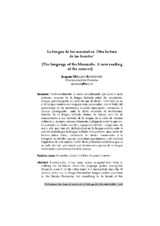Mostrar el registro sencillo del ítem
La lengua de los mozárabes. Otra lectura de las fuentes
| dc.contributor.author | Mellado Rodríguez, Joaquín | |
| dc.date.accessioned | 2018-07-31T10:24:12Z | |
| dc.date.available | 2018-07-31T10:24:12Z | |
| dc.date.issued | 2018 | |
| dc.identifier.issn | 1697-2104 | |
| dc.identifier.uri | http://hdl.handle.net/10396/17114 | |
| dc.description.abstract | Tradicionalmente se viene considerando que poco o nada podemos conocer de la lengua hablada entre los mozárabes, aunque, por otra parte, es conocido que desde el s. VI el latín ya no es la lengua materna en ninguna zona peninsular, sino el fruto del aprendizaje en las numerosas escuelas episcopales, monacales e incluso parroquiales. Ante la obvia ausencia de testimonios directos de la lengua hablada, hemos de buscar una vía de acercamiento a esa realidad de la lengua de la calle de manera indirecta y siempre, inexcusablemente, indagando entre lo que nos ha quedado, los textos escritos, espigando detalles, vulgarismos de acá y allá que han ido deslizándose en la lengua escrita ante la presión ejercida por la lengua hablada. Ensayaremos una suerte de lectura entre líneas, rastreando los textos conservados a la búsqueda de detalles que nos permitan aproximarnos a la realidad lingüística de este amplio sector de la población cordobesa que se ve cada día más presionado por la enorme pujanza de la lengua árabe en la esplendorosa Córdoba omeya. | es_ES |
| dc.description.abstract | Traditionally, it has been widely accepted that little or nothing can be known about the language spoken among the Mozarabs even if, on the other hand, it is known that since the VI century, Latin was no longer the mother tongue spoken anywhere in the Iberian Peninsula, but something to be learnt at the numerous schools belonging to a bishopric, a monastery or even a parish church. As no direct testimonies of the spoken language may be gathered, the reality of the spoken language can only be approached in an indirect manner, and it will always be through a forced search into what has been left in written texts: scrutinizing into details, picking vulgarisms here and there which slipped into the written language due to the pressure exerted by the spoken language. We will put to try some sort of reading between the lines, tracking down language elements preserved in texts that might bring us closer to the linguistic reality of that broad sector of the population of Cordoba that became under growing pressure by the emergence of Arabic in the splendour of the Umayyad caliphate. | es_ES |
| dc.format.mimetype | application/pdf | es_ES |
| dc.language.iso | spa | es_ES |
| dc.publisher | Universidad de Córdoba, UCOPress | es_ES |
| dc.rights | https://creativecommons.org/licenses/by/3.0/ | es_ES |
| dc.source | Collectanea Christiana Orientalia 15, 119-156 (2018) | es_ES |
| dc.subject | Mozárabe | es_ES |
| dc.subject | Latín | es_ES |
| dc.subject | Córdoba (España) | es_ES |
| dc.subject | Hispania | es_ES |
| dc.subject | Fuentes | es_ES |
| dc.subject | Mozarabs | es_ES |
| dc.subject | Latin | es_ES |
| dc.subject | Hispania | es_ES |
| dc.subject | Sources | es_ES |
| dc.title | La lengua de los mozárabes. Otra lectura de las fuentes | es_ES |
| dc.title.alternative | The language of the Mozarabs. A new reading of the sources | es_ES |
| dc.type | info:eu-repo/semantics/article | es_ES |
| dc.relation.publisherversion | http://www.uco.es/servicios/publicaciones/revistas/index.php/cco/index | es_ES |
| dc.rights.accessRights | info:eu-repo/semantics/openAccess | es_ES |

